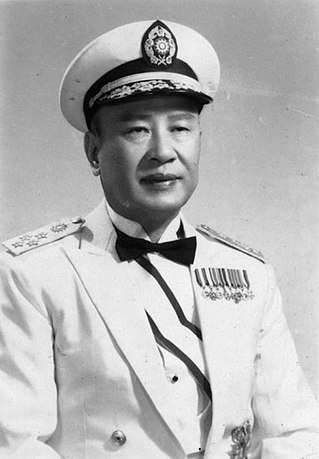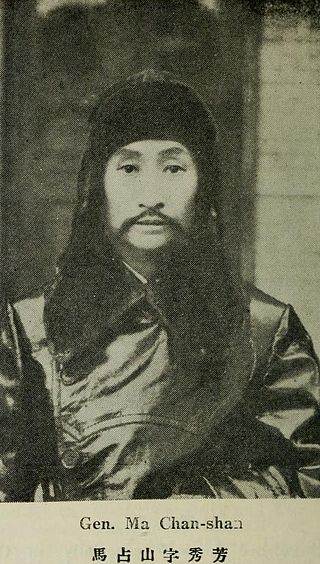
Bai Chongxi was a Chinese general in the National Revolutionary Army of the Republic of China (ROC) and a prominent Chinese Nationalist leader. He was of Hui ethnicity and of the Muslim faith. From the mid-1920s to 1949,Bai and his close ally Li Zongren ruled Guangxi province as regional warlords with their own troops and considerable political autonomy. His relationship with Chiang Kai-shek was at various times antagonistic and cooperative. He and Li Zongren supported the anti-Chiang warlord alliance in the Central Plains War in 1930,then supported Chiang in the Second Sino-Japanese War and the Chinese Civil War. Bai was the first defense minister of the Republic of China from 1946 to 1948. After losing to the Communists in 1949,he fled to Taiwan,where he died in 1966.

The National Revolutionary Army,sometimes shortened to Revolutionary Army (革命軍) before 1928,and as National Army (國軍) after 1928,was the military arm of the Kuomintang from 1925 until 1947 in China. It also became the regular army of the Republican era during the KMT's period of party rule beginning in 1928. It was renamed the Republic of China Armed Forces after the 1947 Constitution,which instituted civilian control of the military.

Liu Zhi was a prominent Kuomintang military and political leader in the Republic of China.

Chen Cheng was a Chinese political and military leader,and one of the main commanders of the National Revolutionary Army during the Second Sino-Japanese War and the Chinese Civil War.

Chiang Wei-kuo,also known as Wego Chiang,was the adopted son of Republic of China President Chiang Kai-shek,the adoptive brother of President Chiang Ching-kuo,a retired Army general,and an important figure in the Kuomintang. His courtesy names were Jian'gao (建鎬) and Niantang (念堂). Chiang served in the Wehrmacht before fighting in the Second Sino-Japanese War and Chinese Civil War.

Tang Shengzhi was a Chinese warlord during the Warlord Era,a military commander during the Second Sino-Japanese War and a politician after World War II.

The Wang Jingwei regime or the Wang Ching-wei regime is the common name of the Reorganized National Government of the Republic of China,the government of the puppet state of the Empire of Japan in eastern China called simply the Republic of China. This should not be confused with the contemporaneously existing National Government of the Republic of China under Chiang Kai-shek,which was fighting with the Allies of World War II against Japan during this period. The country was ruled as a dictatorship under Wang Jingwei,a very high-ranking former Kuomintang (KMT) official. The region that it would administer was initially seized by Japan throughout the late 1930s with the beginning of the Second Sino-Japanese War.

Zhang Zhizhong or Chang Chih-chung was a Chinese military commander and politician,general in the National Revolutionary Army of the Republic of China and later a pro-Communist politician in the People's Republic of China.
Zhang FakuiCBE was a Chinese Nationalist general who fought against northern warlords,the Imperial Japanese Army and Chinese Communist forces in his military career. He served as commander-in-chief of the 8th Army Group and commander-in-chief of NRA ground force before retiring in Hong Kong in 1949.

Pang Bingxun was a high-ranking nationalist military commander who fought against the Imperial Japanese Army and Chinese Communist Army. He stopped the IJA 5th Division led by General SeishirōItagaki,one of the principal architects of the 1931 Manchurian incident,from capturing Linyi and converging with General Rensuke Isogai's IJA 10th Division at Tai'erzhuang District,foiling their plan to assault Xuzhou.
The He-Umezu Agreement was a secret agreement between the Empire of Japan and the Republic of China that was concluded on 10 June 1935,two years prior to the outbreak of general hostilities during the Second Sino-Japanese War.

Yu Xuezhong was a general in the armed forces of the Republic of China during World War II,and later a pro-Communist politician in the People's Republic of China,after Mao Zedong took power.

Ma Zhanshan was a Chinese general famous for resisting the Japanese invasion of Manchuria. Ma was placed in charge of the Northeastern Army in Heilongjiang Province during the invasion and ignored orders from the central government not to resist the Japanese. He became a national hero in China by fighting the unsuccessful but highly symbolic Jiangqiao campaign against the Kwantung Army's advance into Heilongjiang. After his defeat,he feigned defection to the Japanese and was appointed Minister of War in the new Japanese puppet state of Manchukuo. He then joined and took command of the guerrilla campaign against Japanese occupation,taking with him large amounts of supplies,funds,and military intelligence. Ma Zhanshan rejoined the Northeastern Army after the guerilla movement was largely defeated. He continued to oppose Chiang Kai-shek's policy of non-resistance and supported the Xi'an Incident that forced Chiang to form the Second United Front with the Chinese Communist Party (CCP). He commanded several units in the National Revolutionary Army during the Second Sino-Japanese War while covertly cooperating with the CCP. Ma avoided direct participation in the postwar Chinese Civil War and eventually defected the Communists,dying a year later in 1950.

The Presidential Palace in Nanjing,Jiangsu,China,housed the Office of the President of the Republic of China from 1927 until the capital was relocated to Taipei in 1949. It is now a museum called the China Modern History Museum. It is located at No.292 Changjiang Road,in the Xuanwu District of Nanjing.

Shang Zhen was a general of the National Revolutionary Army during the Warlord Era,Second Sino-Japanese War and World War II. He was an early 20th century field general who won his share of wars and successful retreats. He then represented China's military in Washington and other international settings during World War II and post war Japan.

Li Pinxian was a Republic of China Army general from Cangwu County,Guangxi. His career spanned the Xinhai Revolution,Warlord Era,the Second-Sino Japanese War,and the Chinese Civil War. After the loss of the mainland to the Chinese Communist Party in 1949,he left for Taiwan.

Li Jishen or Li Chi-shen was a Chinese military officer and politician,general of the National Revolutionary Army of the Republic of China,Vice Chairman of the People's Republic of China (1949–1954),Vice Chairman of the National People's Congress (1954–1959),Vice Chairman the Chinese People's Political Consultative Conference (1949–1959) and founder and first Chairman of the Revolutionary Committee of the Kuomintang (1948–1959).

Liao Yiaoxiang,was a high-ranking Kuomintang commander who successful fought against both the Imperial Japanese Army and Chinese Communist forces. Apart from General Sun Liren,he was one of the few Nationalist commanders who graduated from a military academy in the West. After the end of the Second Sino-Japanese War,he served as a field commander in Manchuria until his capture by Marshal Lin Biao's Manchurian Field Army in the Liaoshen Campaign. General Liao was held for 12 years as a prisoner of war until 1961 and died seven years later during the Cultural Revolution.

Cheng Qian was a Chinese army officer and politician who held very important military and political positions in both the Republic of China and the People's Republic of China. Educated at the Imperial Japanese Army Academy and Waseda University,he first met Sun Yat-sen in Tokyo,becoming an early supporter. Later,under Chiang Kai-shek,he was one of the most powerful members of the Kuomintang,notably serving as Chief of Staff of the Military Affairs Commission during the Second Sino–Japanese War.

Feng Yong was a Chinese educator,military leader and politician. The eldest son of the warlord Feng Delin,Feng Yong was a member of the Standing Committee of the Northeast Administrative Committee. Feng and Zhang Xueliang were born in the same year and grew up together. Theirs fathers were both strong warlords. Zhang Xueliang would become the “Young Marshal”,while Feng chose to set up a Western-style university in China.



























